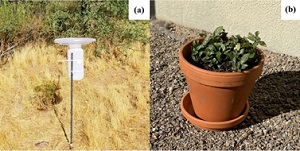Hot Off the Press
Research Briefs
Combined Approach Sheds Light on Global Cancer Risk
About 90% of the global lung cancer risk from polycyclic aromatic hydrocarbons (PAHs) does not come from benzo(a)pyrene, according to a study from the Massachusetts Institute of Technology SRP Center. Some of these other PAHs are not regularly monitored or regulated.
New Passive Sampling Device for PFAS
Researchers from the University of Rhode Island and Brown University SRP Centers developed a new type of passive sampling device for per- and polyfluoroalkyl substances (PFAS). Their new tool overcomes many limitations to traditional approaches, such as detecting short-chain PFAS and low concentrations of the chemicals in water.

Helping Communities Monitor Air Pollution Using Plants
A University of Arizona SRP study revealed that certain plants can be used to effectively monitor metals and other pollutants in air. Community members collected environmental data used in the study as part of the Gardenroots project, which involves residents in research activities to evaluate human and environmental health effects near former and operating mining sites in Arizona.
Environmental Factor Articles
Greenness - vegetation, green spaces, and so forth - is associated with lower mortality risk in cancer patients, even in the presence of air pollution, according to a new NIEHS-funded study at the University of Louisville.
Extramural Paper of the Month: Metabolomics Shed Light on the Microbiota-Brain Link
According to NIEHS-funded researchers at the University of North Carolina at Chapel Hill, the gut microbiome may control conditions in the brain that could lead to altered brain function.
Scientists Design Risk Communication Strategies to Improve Health
Building on their experience sharing such information with diverse groups, researchers from across the U.S. discussed successes, challenges, and recommendations during recent Risk e-Learning Webinars hosted by SRP.
Health Policy Changes in Germany Informed by Trainee Research
Research by the University of Iowa SRP Center informed the amendment of policy in Germany to require stricter controls for facilities using 2,4 -DCBP, a chemical found to emit polychlorinated biphenyls during rubber production.

Artist Uses Tribal Symbolism, Traditions to Communicate Science
Artist Mallery Quetawki and University of New Mexico SRP Center scientists are turning complex environmental health concepts into meaningful images for Native American communities.
Karletta Chief named director of new Indigenous Resilience Center
SRP grantee Karletta Chief, Ph.D., from the University of Arizona, has been named director of the school's new Indigenous Resilience Center. Chief and colleagues will collaborate with tribal leaders and governments to design community-driven solutions that address the adverse effects of environmental challenges among Indigenous groups.
Arsenic, uranium mix may increase diabetes risk in American Indians
Arsenic and uranium may interact to contribute to the development of diabetes in American Indians, according to SRP-funded research. The study reveals how co-exposure to multiple metals may affect metabolism in humans.
Extramural Paper of the Month: Tool Quantifies Differences in DNA Repair Among Individuals
The CometChip, a tool developed with NIEHS funding, can be used to quantify differences in the human body's capacity to repair DNA damage among individuals, according to a recent study.
Novel technology, new contaminants, and safety addressed in training
Through support from SRP, academic institutions are developing educational and training programs for industrial hygienists and scientists in the areas of emerging technologies, new environmental contaminants of concern, and disaster response.
Extramural Paper of the Month: Plant Leaves Work as Reliable Air Monitor in Citizen-Science Study
Working with citizen-scientists, NIEHS-funded researchers demonstrated that leaves can be used as a low-cost, reliable method to assess the level of metals in airborne dust. This method can help assess exposure from former mine sites that emit heavy metals that can be distributed by wind to nearby communities.
to Top



